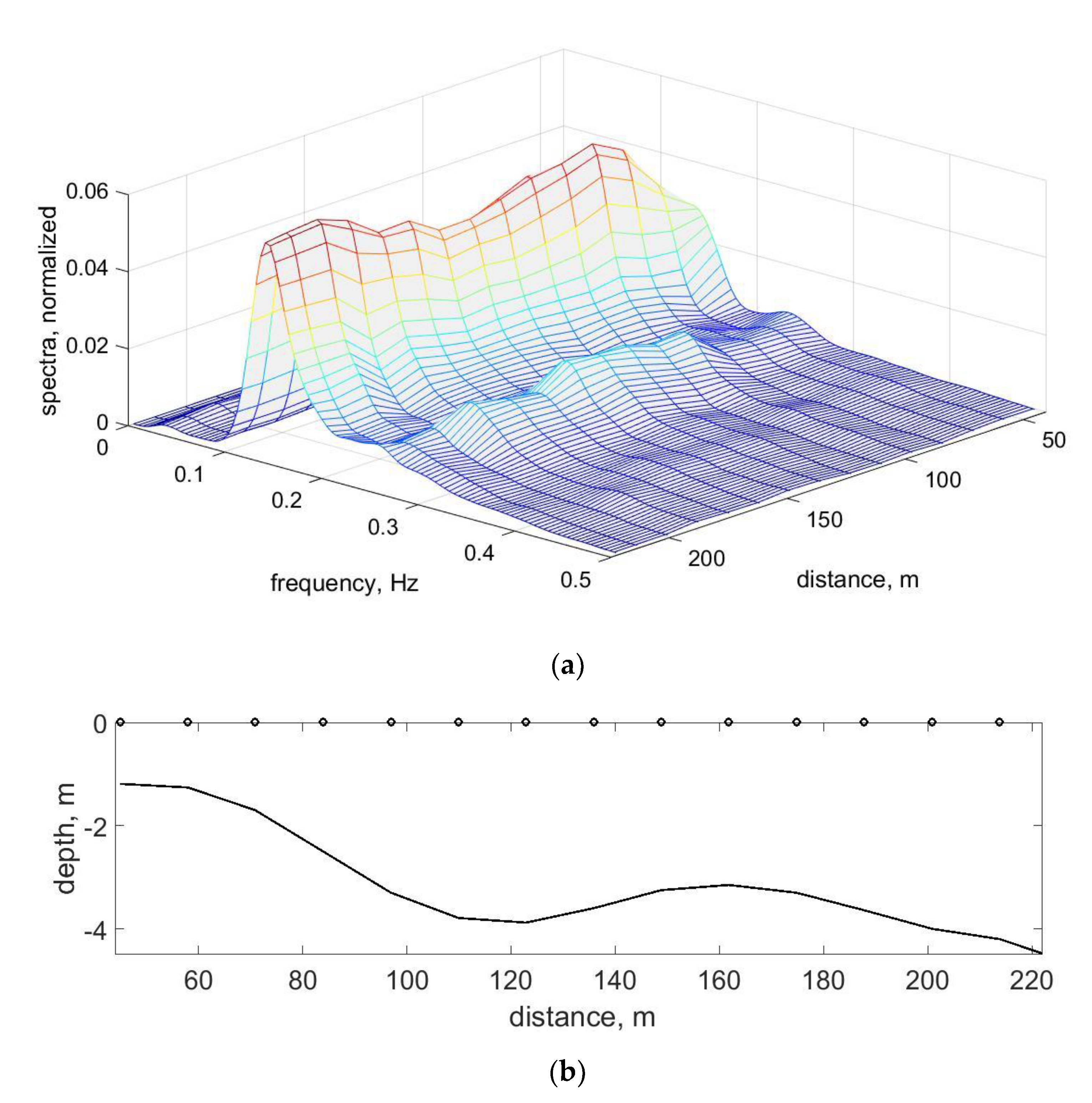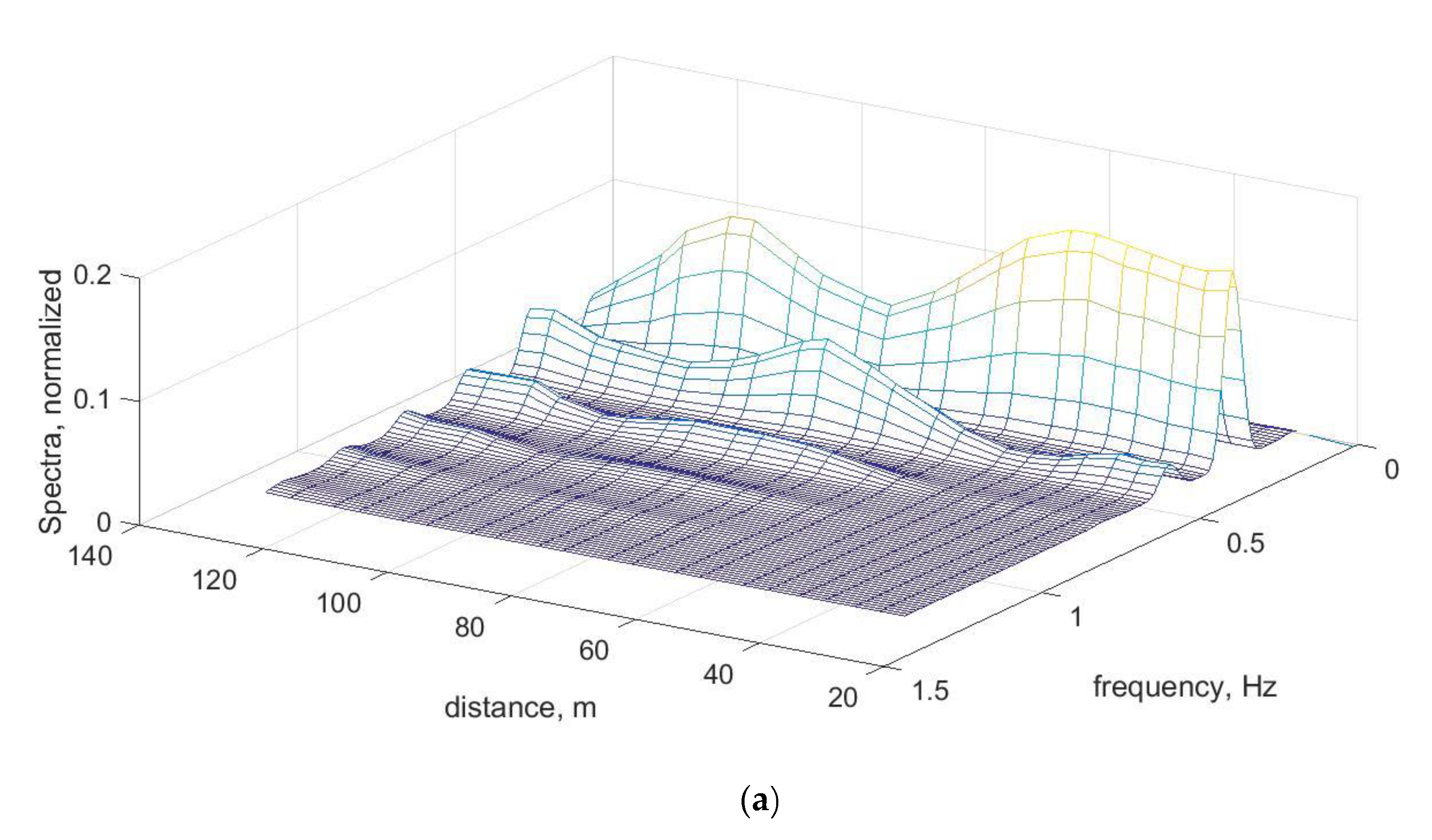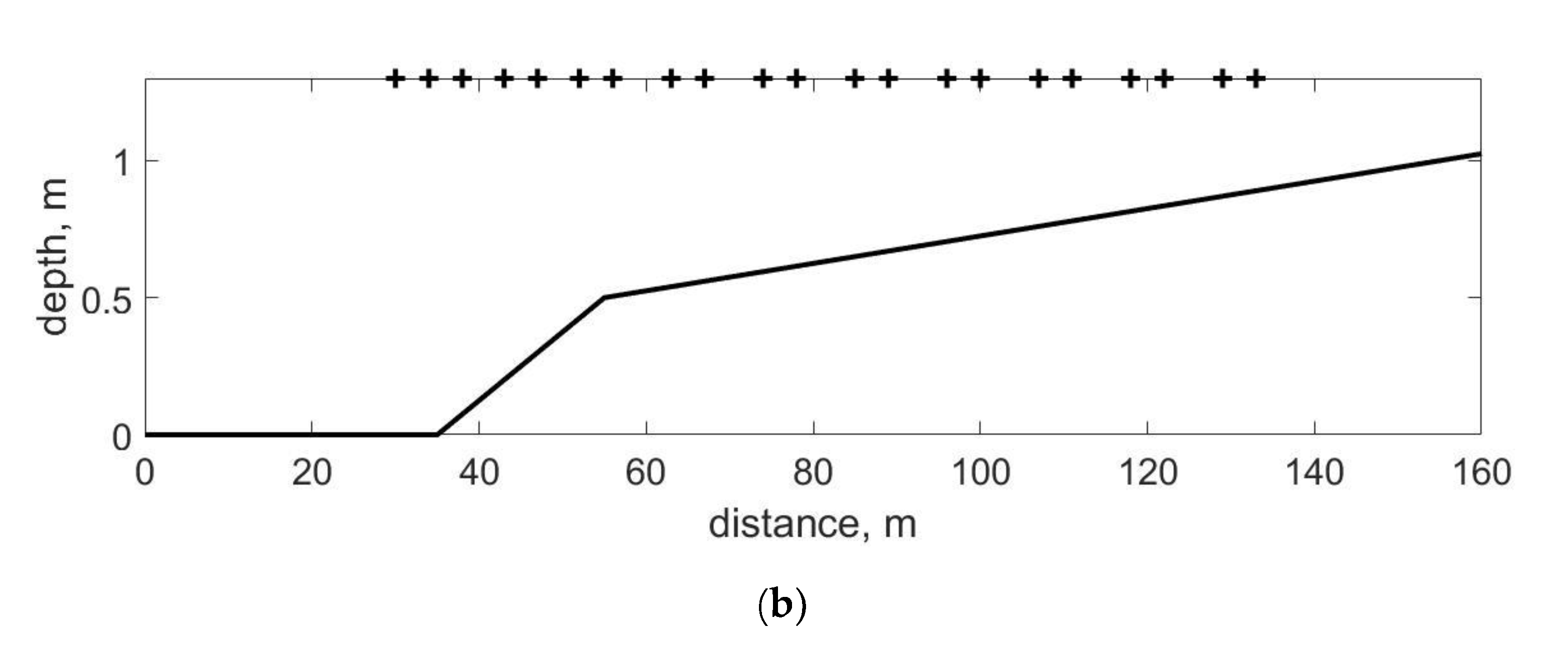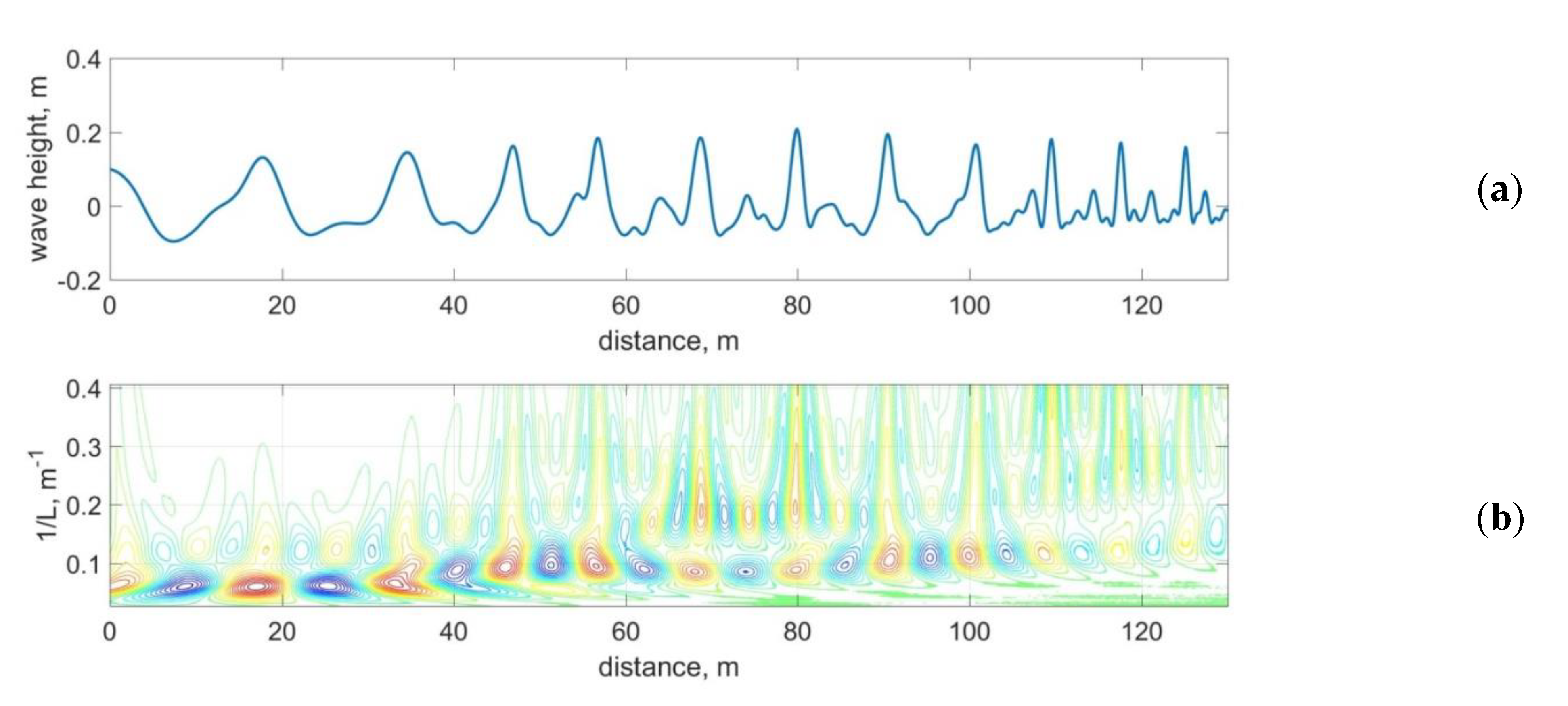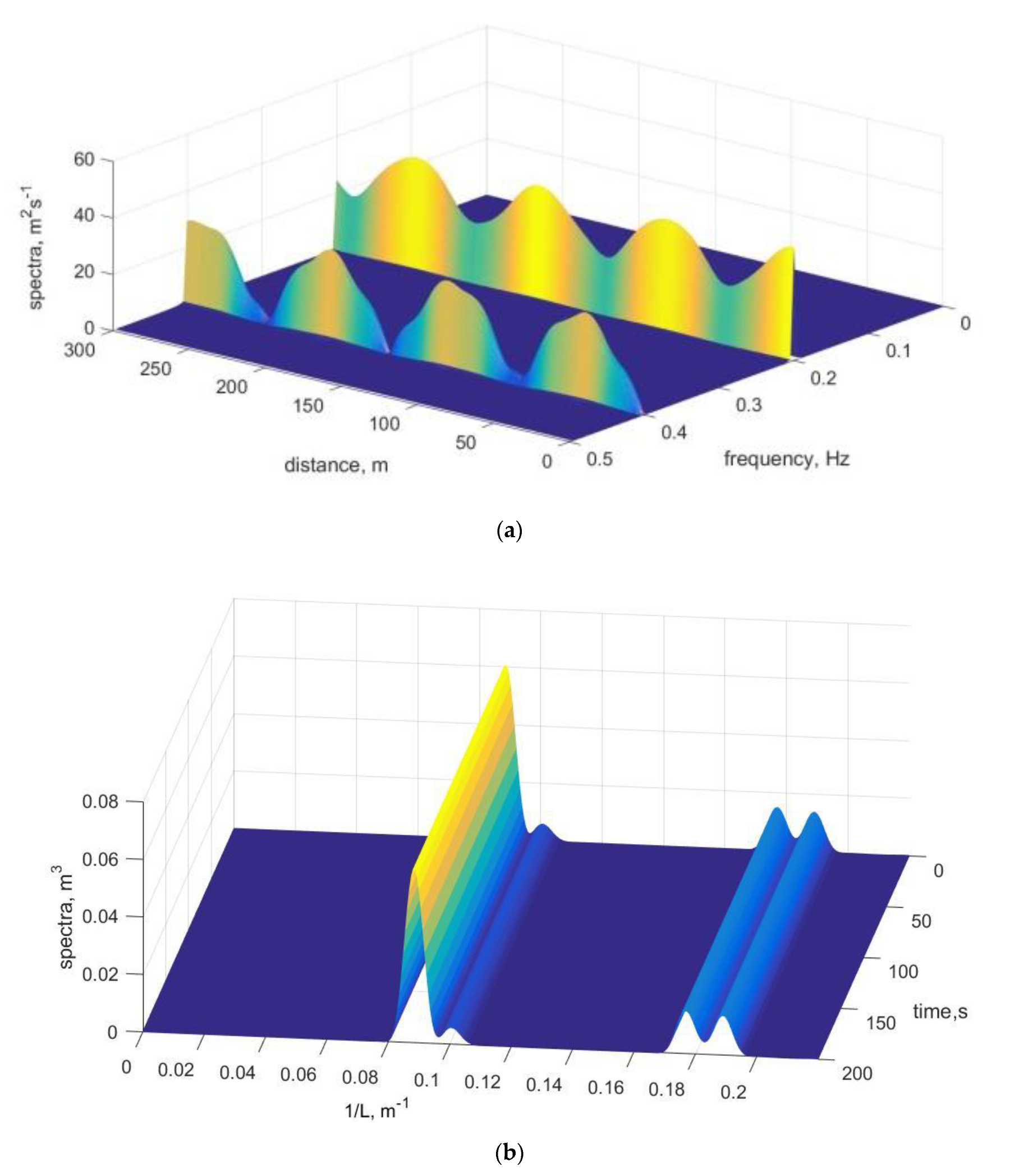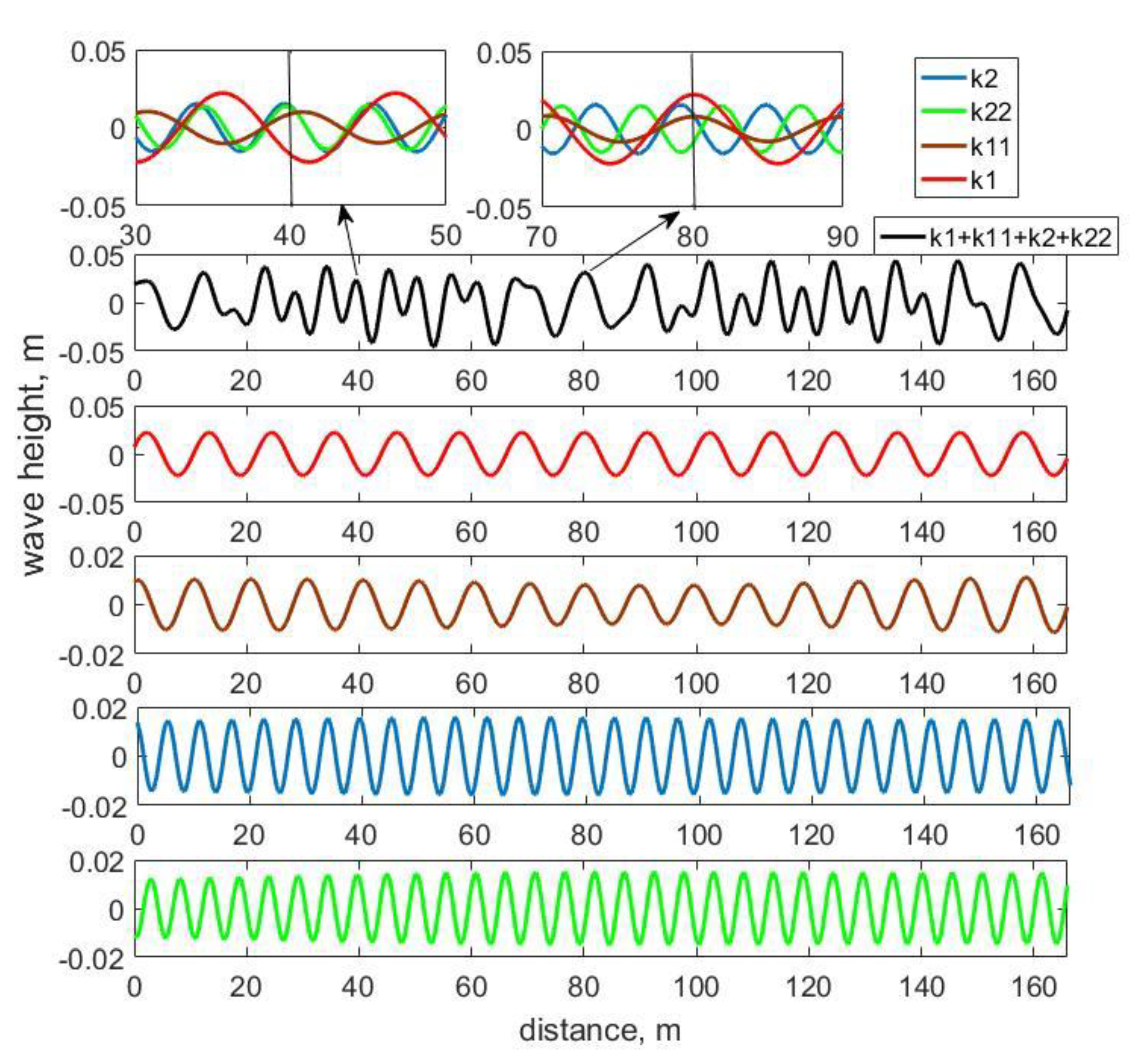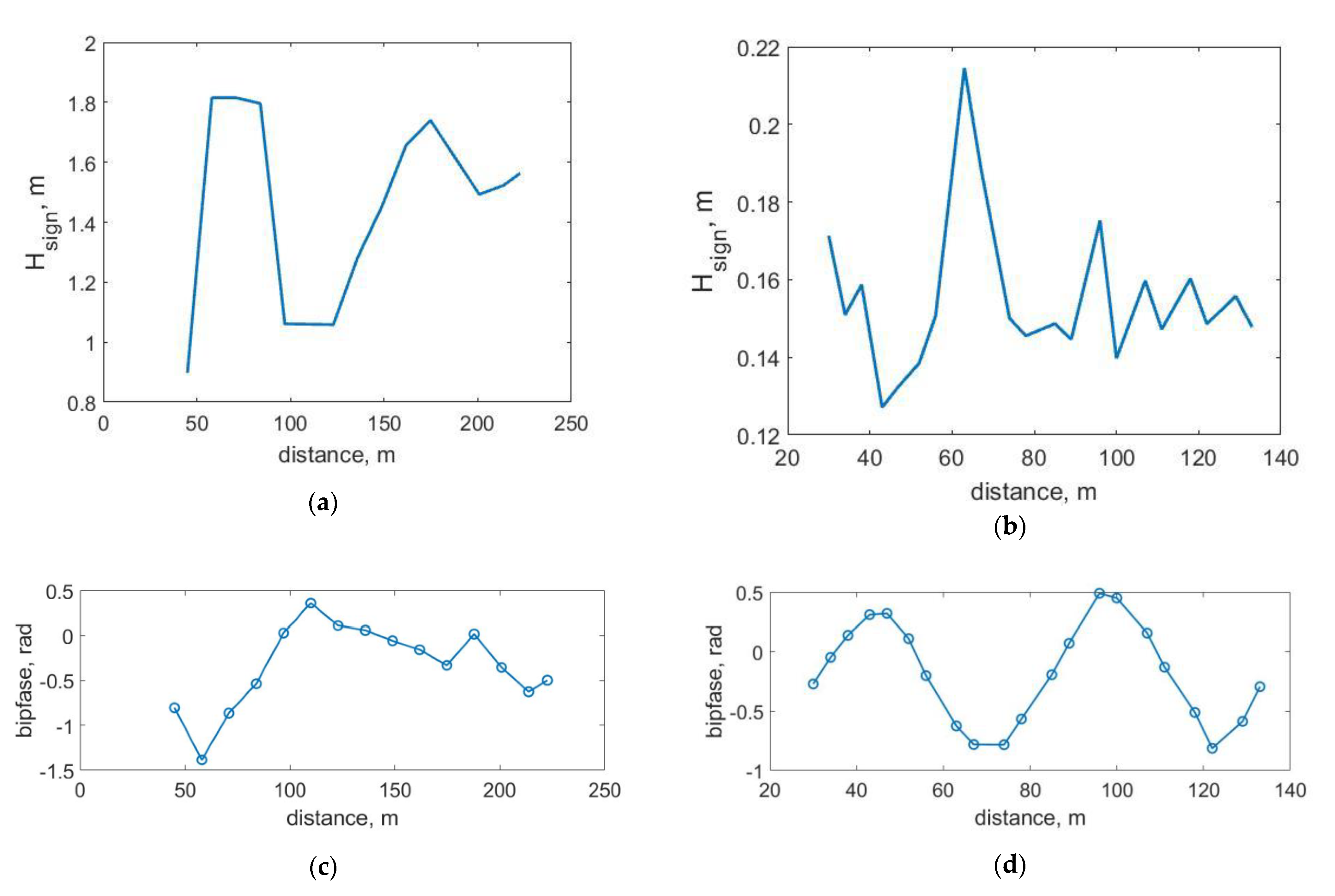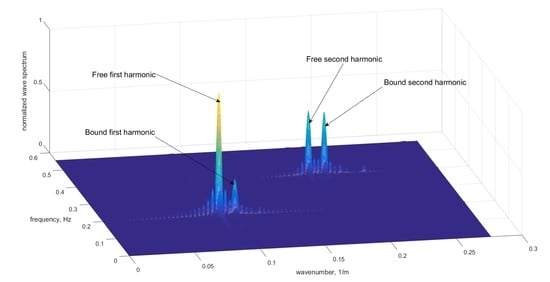1. Introduction
Waves are the main source of energy in the coastal zone of the sea and therefore wave transformation is a factor determining many dynamic processes. In addition, waves affect shore structures, and knowledge about the change in their parameters as the waves approach the shore is necessary to design shore protection from wave impact. The wave parameters and regularities of their change are necessary for solving practical and theoretical problems for the development and recreational exploitation of any coastal zone.
The main feature of nonlinear wave transformation in the coastal zone over slopping bottom is the generation of high-frequency wave components. For the first time, the introduction of free and bound waves in the context of nonlinear wave interaction was done in [
1] for the case of four wave interactions on deep water. It was shown that free waves corresponding to dispersion relation during nonlinear interactions can generate bound waves. For the dynamic processes on shallow and intermediate water depth, more important is the second harmonic that consists of free and bound modes. This fact is well-known in the coastal engineering community. However, detailed description of the influence on coexisting free and bound waves on the evolution of wave parameters in the coastal zone is missing due to absence of analytical solutions and the difficulties to measure the simultaneous time and spatial fluctuations of free surface elevations in physical experiments.
The second nonlinear wave harmonic is important because it is responsible for the shoreward wave component of sediment discharge
q. in accordance with the popular sediment discharge formula, introduced by Bailard [
2] and then simplified by Stive [
3]
where
u1 and
u2 are the amplitudes of first and second harmonics of near-bottom wave velocity which are linearly proportional to the corresponding wave harmonics and
φ is the phase shift between them. If
u2 = 0 or
φ = ±π/2, then
q will be equal to 0. In this case beach erosion will occur because there will be no wave component of sediment transport to the shore and the undertow directed to the sea will prevail.
It was shown that the spatially periodic exchange of energy between the first and second harmonics contributes to the formation and movement of underwater sand bars [
4,
5]. In addition, the periodic exchange of energy between harmonics leads to the arising and disappearance of secondary waves that significantly change the mean wave period [
6,
7].
Phase shift between the first and second wave harmonics
φ influences the type of wave breaking [
8]. The periodic in space energy exchange between wave harmonics during near-resonant three-wave interactions lead to the fluctuations of
φ between ±π/2 for waves propagating above the gentle inclined bottom. In spilling breaking waves,
φ is close to zero, which corresponds to symmetrical on vertical axis. In plunging breaking waves, the phase shift
φ is about −π/2, which corresponds to the forward shifted second harmonic relative to the first one and to the asymmetrical one on a vertical axis. Due to the different symmetry, plunging breaking waves contribute to the erosion of the cross-shore underwater bottom profile between the breaking point and shoreline, while spilling breaking waves contribute to the accumulation of sand on it.
Second harmonics of waves provide the spatial fluctuations of Stokes wave-induced mass transport [
9].
Various measurements are used to determine the change in wave parameters including satellites, radars, LIDARs, ADCPs, etc. However, the most informative from the point of view of the physical study of wave transformation are contact methods which obtain chronograms of individual waves by installing wave gauges (capacitive and resistance type wire gauges or pressure gauges on the bottom) or buoys. The classical spectra of spatial wave fluctuations in the theory of waves on deep water are constructed on the wavenumber. For the coastal zone, the length of which is less than 1 km, and some areas requiring study are even shorter. Therefore, typical spatial scales in coastal zones are from one to several wavelengths. It is not enough to construct reliably accurate wavenumber spectra. Therefore, the changes in wave parameters are estimated based on the spatial evolution of the wave frequency spectra obtained for each wave gauge. How wavenumber and frequency wave spectra differ and how they correspond to each other in determining the changing parameters of waves at decreasing water depths is not well understood.
A decrease of water depth leads to wave transformation and changes of its shape in space. Nonlinear features of wave transformation have been found in many fields, laboratory, and numerical experiments, but their physical interpretation is often difficult due to the lack of comprehensive theoretical solutions describing the transformation of waves under such conditions. The most popular is the theoretical approximation of long waves in shallow water for
kh << 1 where
h is the depth,
k is the wavenumber, supposing that the waves propagate without dispersion. However, in most parts of the coastal zone, waves propagate at the so-called “intermediate depth,” when
kh =
O (1). As shown in [
10], the evolution of such waves is associated with generation of nonlinear harmonics due to near-resonant three-wave (or triad) interactions:
where
ω = ω(
k) is angular frequency connected with the wavenumber by dispersion relation for gravitational waves
ω2 = gk·tanh(
kh),
g is the acceleration of gravity, and
δ is the detuning (or phase mismatch) arising from the impossibility to satisfy the conditions of full resonance (
δ = 0) for this dispersion relation. If we consider the wave equation with first-order boundary conditions describing the propagation of waves at intermediate depth over the horizontal bottom, then we can obtain the solution [
10] consisting of the first harmonic with constant amplitude and two second harmonics, free and bound, with doubled frequency of the first harmonic and the wavenumbers determined from the dispersion relation for the free harmonic and equal to the doubled wavenumber of the first harmonic:
where
is a time,
is a distance, and
is constant amplitude coefficients depending on wavenumber and water depth. The superposition of free and bound second harmonics amplitude in frequency domain leads to spatial fluctuations of the wave amplitude. Theoretically, it was shown [
10] that “free … second harmonic will interact with the primary wave to generate sum and difference frequency.” So, difference interactions between the free first harmonic of waves and the free second harmonic will generate the bound first harmonic with the same frequency as the free, but a different wavenumber.
In [
10] the evolution equations, which numerically give solutions consisting only of bound harmonics in frequency domain with amplitudes slowly varying in space, were suggested also. Numerical solutions of these equations are in good agreement with the data of laboratory measurements [
10].
It is obvious that the beats of the amplitudes of the harmonics slowly varying in space indicate the simultaneous presence of free and bound waves of both the second and the first harmonics. The beat spatial period, as well as the differences between the wavenumbers of free and bound waves, is determined by the mismatch
δ:
The use of second-order boundary conditions on the wavemaker (or initial conditions for the models) allows one to reduce the amplitude of the free second harmonic in some cases, but does not completely suppress them [
10].
Many researchers in the laboratory and numerical experiments with mechanically-generated waves consider free waves of the second harmonic to be parasitic (or spurious) arising due to incorrect setting of the wavemaker moving in monochromatic manner and try to avoid them by the “correct” selection of initial conditions [
10,
11,
12] according to the second order wave maker theory [
13], because free waves make difficult the interpretation of the experimental results. Meanwhile, these “parasitic” free second harmonics also arise during the wave passing over an underwater bar in laboratory experiments or in nature when waves propagate over an inclined bottom [
6,
14].
A free second harmonic coincides with the bound ones when waves propagate without dispersion at very shallow water depths (kh → 0), when the detuning δ will be equal to zero (Formulas (2) and (4)). However, for real conditions of the coastal zone, taking into account the period of incident waves from 6 to 12 s, these depths will be less than half a meter.
The existence of space fluctuation of amplitudes of first and second frequency harmonics during wave propagation over inclined bottom in both field and laboratory conditions definitely confirms the simultaneous coexistence of free and bound waves.
The aim of the work is to demonstrate in detail the role of free and bound waves in the process of nonlinear wave transformation over an inclined bottom in intermediate water depth. For this, (1) a qualitative description of the physics and kinematics of the nonlinear process of wave transformation in the time and spatial domains will be given and (2) the important practical application of free and bound wave conception to explain visible paradoxes arising during the measurements of wave celerity and wave energy distributions across the coastal zone. The study is based on the data of field, laboratory, and numerical experiments and the methods of spectral and wavelet analyses.
3. Discussion of Results
Significant nonlinear changes in the wave shape leads to various paradoxical results when the concepts of wave linear theory are applied to evaluate the characteristics of waves. So, for example, traditional estimates of the potential energy of waves from the point measurements proportional to the square of the significant wave height lead to unexpected fluctuations of the wave energy at different points of measurements that are inexplicable in the frame of the linear wave theory (
Figure 8a). These fluctuations can be explained by the non-periodicity of the nonlinear wave motion, the waves at neighboring points in space differ significantly and it is impossible to replace the integration of the wave surface at its “length” by integrating the energy over the “period” of the wave at the point of measurement.
A similar effect of anomalous wave dispersion arises when estimating the phase velocities of propagation of nonlinear harmonics of waves from measurements at neighboring points [
19]. Due to spatially periodic changes in the symmetry of the waves, the phase shift (biphase) between the first and second frequency harmonics also changes, as shown in
Figure 8b for the discussed data of field and laboratory experiments. The biphase was calculated as was suggested in [
20]:
where
–bispectrum,
ω–angular frequency,
A–complex Fourier amplitudes of free surface elevations,
E–averaging operator.
Fluctuations of the biphase shown in
Figure 8 mean that the second harmonic is shifted forward relative to the first, then backward, which means that its phase velocity is sometimes greater and sometimes less than the phase velocity of the first harmonic.
A theoretical estimation of the phase shift between the first and second frequency harmonics can be obtained by reducing both terms of the second harmonic in Formula (3) to the form:
From (4), it is easy to obtain a biphase φ equal to the doubled phase of the first harmonic minus the phase of the second harmonic [
20]:
The biphase is equal to −π/2 at the initial moment of wave transformation and increases as the wave propagates, reaching 0 at the moment of the maximum amplitude of the second harmonic and continues to increase, which, taking into account the periodicity of trigonometric estimates, leads to fluctuations of the biphase in the range from −π/2 to π/2. This is clearly seen in
Figure 8d.
4. Conclusions
It is shown that the space periodic exchange of energy between the first and second frequecy harmonics exist in the field condition where it arises naturally. According to the concept of free and bound waves, such periodical fluctuations are evidence of their existence.
It was revealed that observed spatial beats or energy exchange between the first and second frequency harmonics are the result of the interference of the free and bound harmonics in wavenumber domain. There are periodical fluctuations in the wave shape corresponding to length beat periods.
Numerical experiments of wave transformation over the constant depth have shown the existence of the bound first harmonic of waves, which has smaller amplitude than the first free one. At the same time, it should be noted the amplitudes of the free and bound second harmonics are equal.
The difference between wave spectra on wavenumber and on frequency for the same wave field on intermediate and shallow water depth was investigated in detail.
When the spatial evolution of frequency spectra is analyzed, the effect of periodic energy exchange between the first and second harmonics of waves (beat) and changes in the phase shift between the harmonics in phase with the beat appear. When the wavenumber spectrum is analyzed, free and bound first and second harmonics with spatially invariable amplitudes are revealed, and all fluctuations of the wave parameters in space are caused by linear interference of these four harmonics.
There are observed fluctuations of the potential energy of waves and the appearance of anomalous dispersion (when the second harmonic celerity is higher than the first one) during the beat. These effects are the shortcoming consequences of the application of linear wave theory concepts of wave frequency and wavenumber to nonlinear waves and are important for estimating the wave parameters on the base of measurements in the coastal zone of the sea.
